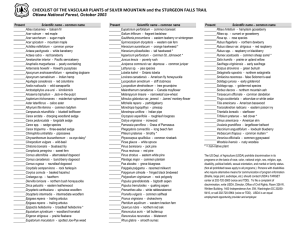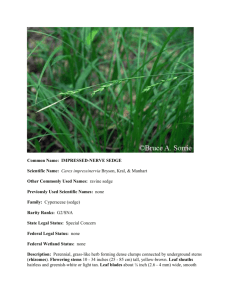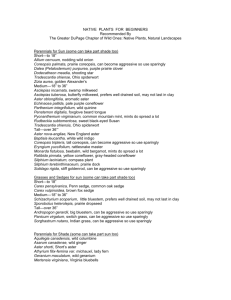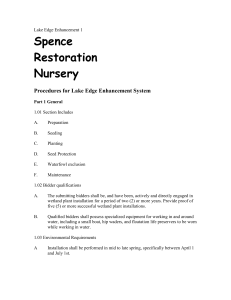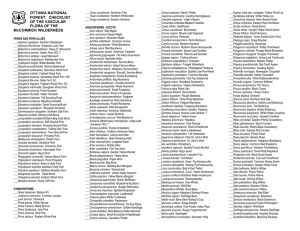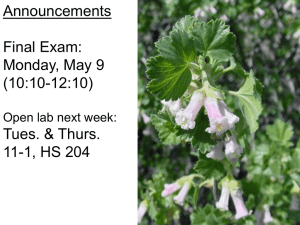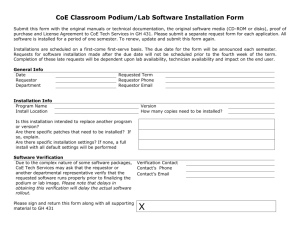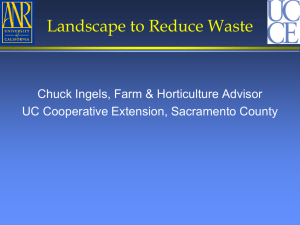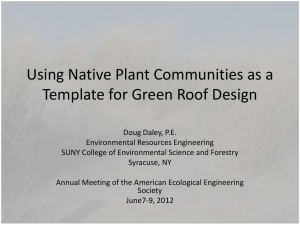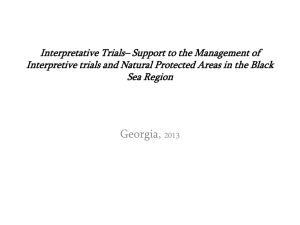Stormwater Wetlands 1 - Spence Restoration Nursery
advertisement
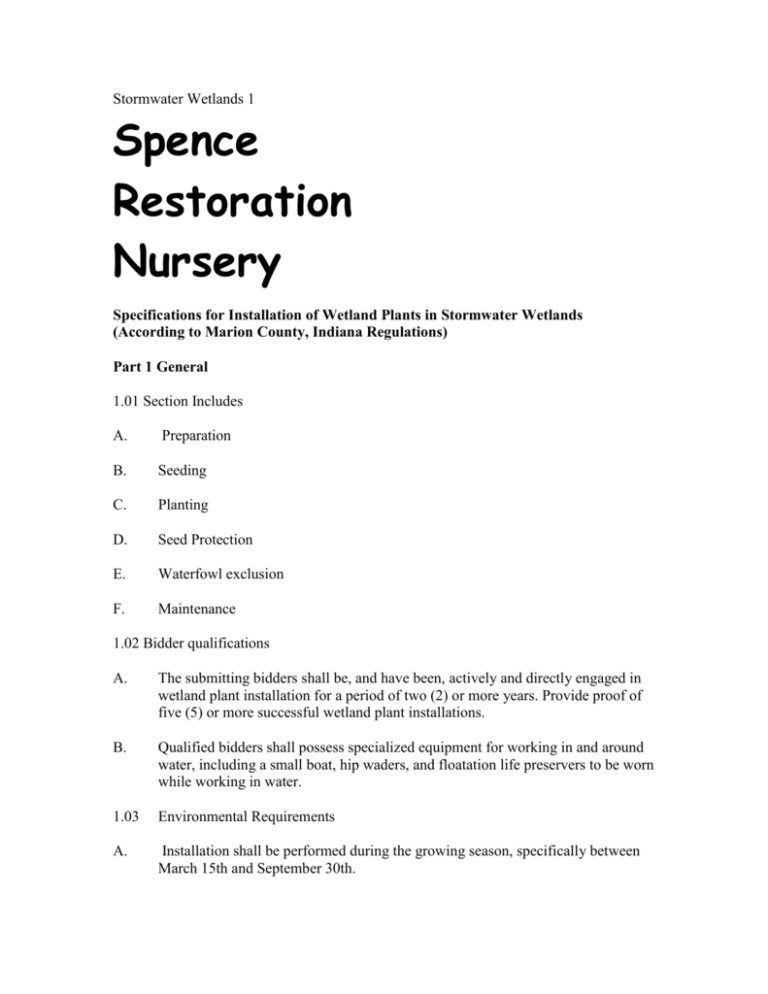
Stormwater Wetlands 1 Spence Restoration Nursery Specifications for Installation of Wetland Plants in Stormwater Wetlands (According to Marion County, Indiana Regulations) Part 1 General 1.01 Section Includes A. Preparation B. Seeding C. Planting D. Seed Protection E. Waterfowl exclusion F. Maintenance 1.02 Bidder qualifications A. The submitting bidders shall be, and have been, actively and directly engaged in wetland plant installation for a period of two (2) or more years. Provide proof of five (5) or more successful wetland plant installations. B. Qualified bidders shall possess specialized equipment for working in and around water, including a small boat, hip waders, and floatation life preservers to be worn while working in water. 1.03 Environmental Requirements A. Installation shall be performed during the growing season, specifically between March 15th and September 30th. Stormwater Wetlands 2 B. Hydrology shall be established prior to installation. Wetland must have an established water level. C. Surrounding uplands shall be stabilized with the specified grass seed mix. No pre-emergent herbicides shall be applied to surrounding turf during the six months prior to installation and for at least 1 year following installation. D. Emergent plants shall be installed prior to seeded communities. 1.04 Materials A. All native seed shall be stored in a cooler at 40 degrees Fahrenheit prior to installation B. 1. All native seed must be of wild ecotype as provided by Spence Restoration Nursery or approved local source. No hybrids or cultivars may be included. 2. Local genotype seed shall be used whenever possible due to its adaptation to local soil and climate. These specifications do not apply to the temporary matrix. Container grown plants shall be used for the emergent plant communities. 1. Container grown plants must be of wild ecotype as provided by Spence Restoration Nursery in 2 3/8”X 3 ¾” open bottomed pots. No hybrids or cultivars may be included. 2. Container grown plants shall be inoculated with pelletized VAM (Vesicular Arbuscular Mycorrhizae) endomycorrhizal fungi as provided by Spence Restoration Nursery or approved source where available. Part II - Products 2.01 Plants A. Low Marsh 6-18 inches Installation must include at least three of the species below, including two aggressive species marked with an asterisk(*). Species noted by the number sign (#) may be installed bare-root. Others must be installed from container grown plants. Pickerel Weed (Pontederia cordata)# Stormwater Wetlands 3 Hard-Stemmed Bulrush (Scirpus acutus) River Bulrush (Scirpus fluviatilis)#* Soft-Stem Bulrush (Scirpus validus)* Giant Burreed (Sparganium eurycarpum)* B. High Marsh: 6 inches or less below normal pool elevations. Installation must include at least 6 of the species below, including two aggressive species marked with an asterisk(*). Sweet Flag (Acorus calamus) Water Plantain (Alisma subcordatum) Bristly Sedge (Carex comosa) Lake Sedge (Carex lacustris)* Tussock Sedge (Carex stricta) Hairy-Fruited Lake Sedge (Carex trichocarpa)* Buttonbush (Cephalanthus occidentalis) Creeping Spike Rush (Eleocharis erythropoda)* Swamp Rose Mallow (Hibiscus palustris) Soft Rush (Juncus effusus) Wild Iris (Iris versicolor) Blue Flag (Iris virginica shrevei) Rice Cut Grass (Leersia oryzoides)* Arrowhead (Sagittaria latifolia)* Lizard’s Tail (Saururus cernuus) Dark Green Bulrush (Scirpus atrovirens) Woolgrass (Scirpus cyperinus) Three-Square Bulrush (Scirpus pungens)* C. Semi-Wet Zone - Areas above normal pool that are occasionally inundated Installation must include container grown plants or a seed mix containing at least 15 species below including two aggressive species marked with an asterisk (*). Species appropriate for shady locations are marked with a carrot (^) Marsh Milkweed (Asclepias incarnata) Shining Aster (Aster firmus) New England Aster (Aster novae-angliae) Swamp Aster (Aster puniceus) Flat-Topped Aster (Aster umbellatus) Tall Brome (Bromus latiglumis)^ Blue-Joint Grass (Calamagrostis canadensis)* Marsh Marigold (Caltha palustris)^ Brome Hummock Sedge (Carex bromoides)^ Fringed Sedge (Carex crinita)^ Stormwater Wetlands 4 Crested Sedge (Carex cristatella) Riverbank Tussock Sedge (Carex emoryi)* Frank’s Sedge (Carex frankii)^ Meadow Sedge (Carex granularis)^ Burr Sedge (Carex grayi)^ Porcupine Sedge (Carex hystericina) Bottlebrush Sedge (Carex lurida) Palm Sedge (Carex muskingumensis)^ Spreading Oval Sedge (Carex normalis)^ Short’s Sedge (Carex shortiana) Narrow-Leaf Cattail Sedge (Carex squarrosa)^ Awl-Fruited Sedge (Carex stipata)^ Pointed Oval Sedge (Carex tribuloides) Fox Sedge (Carex vulpinoidea ) White Turtlehead (Chelone glabra)^ Pink Turtlehead (Chelone obliqua)^ Hollow Joe-Pye Weed (Eupatorium fistulosum) Spotted Joe-Pye Weed (Eupatorium maculatum) Boneset (Eupatorium perfoliatum) Queen of the Prairie (Filipendula rubra) Fowl Manna Grass (Glyceria striata)^ Autumn Sneezeweed (Helenium autumnale) Torrey’s Rush (Juncus torreyi)* Cardinal Flower (Lobelia cardinalis)^ Great Blue Lobelia (Lobelia siphilitica)^ Common Mint (Mentha arvensis) Monkey Flower (Mimulus ringens) Obedient Plant (Physostegia virginiana) Golden Ragwort (Senecio aureus)^ Ohio Goldenrod (Solidago ohiensis) Swamp Goldenrod (Solidago patula) Riddell’s Goldenrod (Solidago riddellii) Prairie Cord Grass (Spartina pectinata) Tall Ironweed (Vernonia altissima) Smooth Ironweed (Vernonia fasciculata) 2.02 Accessories A. Waterfowl Exclusion 1. 2. Posts - 6 foot lightweight fence posts Fence - 4 foot width of plastic filaments with 1 inch square openings. B. Potting mix – Sterile dry potting mix composed of a light-weight vermiculite mix Stormwater Wetlands 5 Part III Execution 3.01 Examination A. Verify that a stable water level has been established in the wetland. B. Verify that the surrounding uplands have been stabilized with the specified grass seed mix. 3.02 Preparation A. Two weeks (14 days) prior to installation, apply a glyphosate herbicide approved for use around water (Rodeo) to the area to kill existing vegetation. B. Following a complete kill of existing vegetation, begin installation by tilling any areas to be seeded to a depth of 3 inches. Till as close to the shoreline as soil moisture conditions permit. Do not till areas where live plants are to be installed. 3.03 Installation of waterfowl exclusion fence A. Place posts on 15 ft centers. Each post shall be driven approximately 1 foot into the pond bottom. Install fence to form 15' X 15' enclosures. Form each enclosure immediately following installation of plants. Planted areas shall not remain unprotected overnight. B. Attach fence to posts with wire ties so that the fence extends to the pond bottom and at least 30 inches above the waters surface. 3.04 Installation of Plants A. All aquatic plants must be installed in the appropriate water depths where protected by waterfowl exclusion fence and the shore. 50% of the 15'X 15' enclosures shall be planted according to the specifications below. 1. Low marsh plants shall be installed 6-18 inches below normal pool elevation. Install plants on 2' centers. Evenly distribute each species around the pond, planting in groups of 3 to 5 plants of each species. 2. High marsh species shall be installed 6 inches or less below the normal pool elevation. Install plants on 18" centers. Evenly distribute each species around the pond, planting in groups of 3 to 5 plants of each species. 3. Semi-Wet zone species shall be installed in areas above normal pool elevation that are inundated by larger storm events. These species shall be Stormwater Wetlands 6 installed as either container grown plants on 12" centers or an approved seed mix containing species from the above list. B. All low and high marsh plants shall be installed by creating a hole with a spade or dibble, placing the plants in the hole and firmly packing the soil around them. Plants allowed to float to the surface following installation shall result in rejection of the installation. C. Plants installed in the semi- wet zone shall be installed by creating a hole with a gas powered hand-held auger. 1. Holes shall be created in a staggered pattern on 1 foot centers. 2. Plant plugs level with existing soil grade. Be certain that soil is placed around the plugs and firmed into place. Do not fill around plugs with mulch. 3. Thoroughly soak plugged area with water until soil is moist to a depth of 4 inches. 3.05 Seeding A. Place a portion of the seed in a clean, dry 5 gallon bucket. Mix 2 parts potting mix with 1 part seed. Thoroughly mix seed and potting mix. B. Hand broadcast potting mix/seed mixture across the specified tilled area. Apply half of the mixture over the entire area. Apply the second half over the same area utilizing the same procedure. This method prevents using all of the seed before the entire area is covered. C. Lightly firm seedbed with a roller where soil moisture permits. Do not roll areas where soil is moist enough to stick to the roller. 3.06. Protection A. Protect seeded areas with stakes and tape around area periphery. 3.07. Maintenance A. Pull weeds of the following invasive species deemed detrimental to wetland plantings. Purple Loosestrife (Lythrum salicaria) Common Reed (Phragmites australis) Stormwater Wetlands 7 Cattails (Typha spp) B. Remove unwanted woody seedlings in shoreline areas including Cottonwood (Populus deltoides), Willow (Salix spp), and Silver Maple (Acer saccharinum). C. If weed growth exceeds ten inches in height in seeded areas, trim or mow to 4 inches. Do not cut areas where live plants were installed. D. Maintain waterfowl exclusion fence for 1 year. At the end of that period, remove fence and posts. 3.08 Acceptance A. Planted Wetland Communities - For acceptance at the end of the first growing season, the following condition shall be met for areas where live plants were installed. 1. 75% of the species planted shall be alive and present. 2. 50 % of the water surface in the shallow water community shall be covered with vegetation. 3. 25 % of the water surface in the floating leaf community shall be covered with vegetation. B. Seeded Native Communities - For acceptance at the beginning of the second growing season, the following conditions shall be met. 1. Coverage - 80 % of each plant community shall be covered with by vegetation. 2. Presence - 50 % of the species planted should be alive and present. 3. Abundance - 50 % of the vegetation should native species of the permanent matrix.
